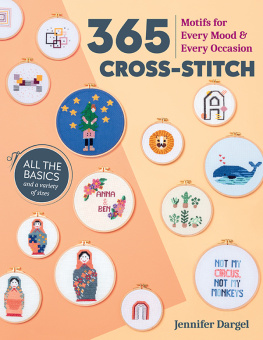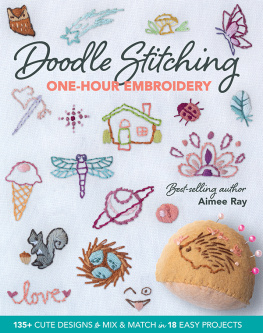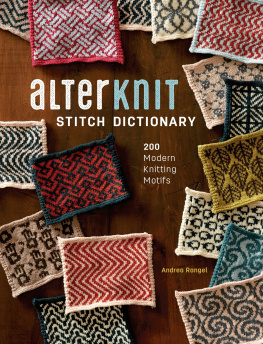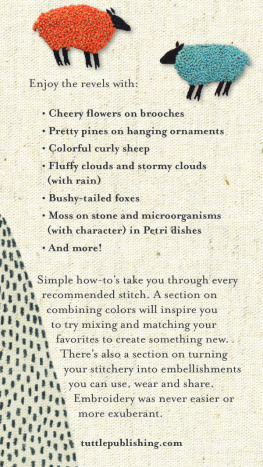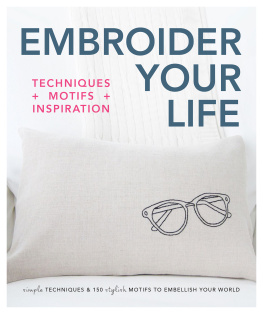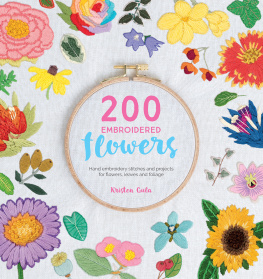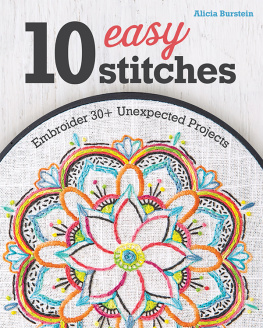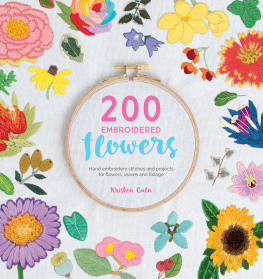How to
Embroider
Almost Everything
A SOURCEBOOK OF 500+ MODERN MOTIFS & EASY STITCH TUTORIALS LEARN TO DRAW WITH THREAD
WENDI GRATZ

INTRODUCTION
I like to think of embroidery as drawing or coloring in slow motionwith thread. Its one of the most delightful ways I know how to spend a few minutes, or a few hours. I love to embroider while I watch television, but I also enjoy embroidering in front of a fire, with no music or television in the background, just listening to the sound of the thread being pulled through the fabric. Its like a meditation.
Even if I never did anything with my finished stitching, I would love the process. But there are so many ways to use your work! You can add a bit of embroidery to your clothes, of course. A little cluster of flowers around the hem of your jeans, a bird on your collar, cute cats scampering up a scarf, a fancy border around the brim of a hatthey all look great.
But there are even many more possibilities! You can stitch a test tube and Bunsen burner on a backpack, cute veggies on your shopping bags, colorful cocktails on pretty cloth napkins, kitchen appliances on your dishtowels. Pillowcases, table runners, canvas sneakerstheres fabric all around, just waiting for you to dress it up with a needle and thread.
Embroidery has been around for ages, and there are encyclopedias full of complicated stitches, but when it comes down to it all you really need are lines, dots, and teardrops. With just a few basic stitches (youll learn them all in this book) you can stitch anything you can imagine. In this book youll find more than 500 designs to get you started, everything from alligators, bicycles, and corn on the cob, to washing machines, yucca plants, and zebras. Have fun with them! Make them bigger or smaller! Use whatever colors you like! Stitch them on anything you can stab with a needle!
And thenkeep going. If you can draw it, you can stitch it! Embroider your world and have fun doing it. :-)
GETTING STARTED
A brief review of embroidery materials, tools, supplies, and basic techniques are all you need to create the wonderful stitch patterns in this book.
Fabric, Thread, Hoops & Needles
You dont need a lot of specialty tools to embroider. When it comes down to it, all you really need is fabric, a needle, and thread. A hoop to hold your fabric and some type of pattern transfer material make things easier, but even theyre not absolutely necessary.
Heres a little more information about fabric, thread, and some of my favorite tools and suppliesto you get started.
FABRIC
If you can put a needle through it, you can embroider it. Ive embroidered through window screens, wood, and even metal (drilling some holes first), but fabric is the easiest, and non-stretchy fabric is the easiest of all. If youre just getting started, I recommend just about any smooth, solid fabric that isnt stretchy. It can be heavyweight (like denim) or lightweight (like a sheer curtain). If you use lightweight fabric, you might want to back it with a fusible interfacing. Interfacing helps stabilize the fabric, and keeps the threads on the back of your work from showing through to the front.
There are some fabrics, like stretchy T-shirt fabric, that require a few extra steps to prepare the fabric so its easier to stitch (see Working with All Types of Fabrics, shown ).

THREAD
If you can thread it through the eye of a needle, you can embroider with it! Embroidery floss, ribbon, yarn, cordeven rope, if you can find a needle with a big enough eyeall work beautifully.
For beginners, I recommend using 6-strand embroidery floss. Its inexpensive, easy to find in lots and lots of different colors, and the separating strands make it easy to adjust to the thickness you want.

EMBROIDERY HOOPS
Embroidery hoops, available in several sizes, hold your fabric tight and smooth, making it easy to embroider neatly. I like colorful, plastic hoops with a big nut for easy tightening. Wooden hoops are inexpensive and easy to find, just make sure they dont have any splinters. I recommend getting a few different sizes; 4-inch (100 mm), 7-inch (180 mm), and 12-inch (300 mm) hoops are the most popular.

NEEDLES
Embroidery needles have a larger eye than sewing needles (called sharps). You can buy needles in packs of assorted sizes. A set of size 510 needles works well for most embroidery.
If you want to embroider with extra-thick thread, look for chenille needles. They have a larger eye than embroidery needles. Tapestry needles also have large eyes, but they have a rounded (not sharp) point and dont work as well with most fabrics.
Your Portable Toolkit
This is itthis is all you need! I keep my tools (extra needles in different sizes and a pair of small, sharp scissors) in an old Altoids tin so I can carry them around in my purse. Embroidery is a terrific, portable craft.
Pattern Transfer Supplies & Methods
There are two easy ways to transfer an embroidery pattern onto your fabric. You can trace your pattern directly onto the right side of the fabric with a pencil or erasable pen or you can use a pattern transfer stabilizer, like Sulky Sticky Fabri-Solvy.

PATTERN TRANSFER SUPPLIES
Pencils and Erasable Pens. A regular pencil works great, and Ive been known to use the closest ball point pen. In most cases, your stitching will cover the lines you draw so you dont need any fancy tools. If youre worried about covering your lines completely (maybe youre stitching with very thin thread?) you can use a water soluble or air-soluble pen both of which are easy to find at any fabric store. Just be careful with air-soluble pens on a big project! The markings last anywhere from minutes to days, depending on the fabric and the amount of humidity in the air. You dont want your lines to disappear before you finish your stitching!
Pattern Transfer Stabilizers. There are many types of pattern transfer products. I like to use Sulky Sticky Fabri-Solvy. I call it the magical embroidery stuff because it makes it easy to embroider on all kinds of fabrics. This product is a stabilizer and pattern transfer material that sticks to the front of your fabric, making it particularly useful for transferring patterns on dark and textured fabrics, like dark denim, felt, velvet, terrycloth, fleece, and even stretchy fabrics. I actually use it for all my stitching because Im lazy and I dont like to trace. It really is magical!



